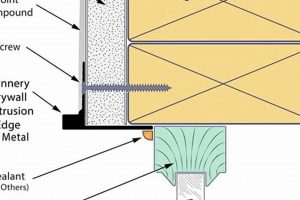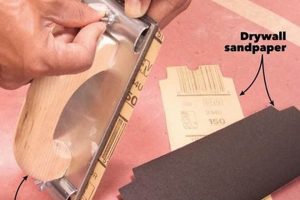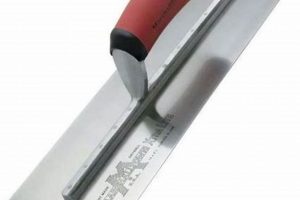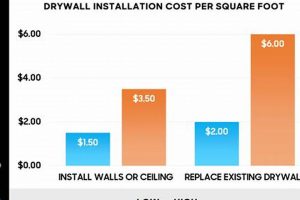The process of applying joint compound and reinforcing materials to the external angles formed where drywall sheets meet is a critical step in wall construction. This procedure ensures a smooth, durable, and aesthetically pleasing transition between surfaces. An example includes applying paper or metal corner bead, followed by multiple coats of joint compound, sanded smooth, to create a seamless 90-degree edge on a wall.
Proper execution of this technique yields several advantages. It protects the vulnerable edges of the drywall from impact damage, significantly extending the lifespan of the wall. Furthermore, it contributes to a professional appearance by eliminating imperfections and providing a crisp, clean line. Historically, this task has evolved from using simple mud and tape to employing specialized products and techniques designed for improved durability and ease of application.
The subsequent sections will delve into specific methods, materials, and best practices for achieving optimal results, covering topics such as corner bead selection, compound application techniques, sanding protocols, and common problem-solving strategies.
Essential Techniques for Edge Treatment
The following guidelines provide essential insights for achieving professional-grade results in edge treatment. Adhering to these recommendations will contribute to enhanced durability and a visually appealing finish.
Tip 1: Corner Bead Selection: Choose the appropriate corner bead material based on the application environment. Metal beads offer superior impact resistance in high-traffic areas, while paper-faced metal beads provide a better surface for compound adhesion and minimize cracking.
Tip 2: Accurate Bead Installation: Ensure the corner bead is perfectly aligned and securely fastened to the drywall. Misalignment or loose installation will result in an uneven finish and potential cracking along the edge. Use appropriate fasteners, such as nails or screws, spaced evenly along the bead’s length.
Tip 3: Thin Coat Application: Apply joint compound in thin, even coats. Multiple thin coats are superior to a single thick coat, which is prone to shrinking, cracking, and difficulty in sanding. Allow each coat to dry completely before applying the next.
Tip 4: Wide Knife Technique: Employ a wide drywall knife (10-12 inches) to feather out the compound smoothly onto the adjacent wall surfaces. This technique minimizes visible lines and creates a seamless transition from the corner to the wall.
Tip 5: Adequate Drying Time: Allow sufficient drying time between coats of joint compound. Premature sanding can lead to gouging and uneven surfaces. Consider environmental factors such as humidity and temperature, which can affect drying time.
Tip 6: Sanding Precision: Utilize a sanding block or pole sander with fine-grit sandpaper (120-150 grit) for achieving a smooth finish. Avoid excessive sanding, which can expose the corner bead or damage the surrounding drywall paper. Employ proper lighting to identify imperfections during the sanding process.
Tip 7: Dust Control: Implement dust control measures during sanding to minimize airborne particles. Use a vacuum sander or wear a dust mask to protect respiratory health and maintain a clean working environment.
Consistent application of these techniques ensures a durable, aesthetically pleasing edge that resists damage and contributes to the overall quality of the wall finish.
The subsequent section will address common challenges and troubleshooting strategies related to this critical finishing process.
1. Corner bead selection
The initial choice of corner bead material directly influences the outcome of finishing external drywall junctures. Different materials offer varying degrees of impact resistance, adhesion properties, and ease of application, thereby affecting the durability and aesthetic quality of the finished corner. Metal corner beads, for example, provide robust protection against physical damage in high-traffic areas. However, they may present challenges regarding compound adhesion if not properly prepared. In contrast, paper-faced metal beads facilitate enhanced compound bonding, reducing the risk of cracking and chipping. The selection process, therefore, necessitates a careful evaluation of the environment and intended use of the wall.
Consider, for instance, a hallway corner subject to frequent contact with furniture or foot traffic. In this scenario, a heavy-gauge metal corner bead would be the preferable choice to prevent damage. Conversely, in a residential living room, a paper-faced metal bead might suffice, prioritizing a smooth, seamless finish over extreme impact resistance. Furthermore, specialized corner beads are available for unusual angles or curved surfaces, requiring a nuanced understanding of available options and their respective application techniques. Incorrect corner bead selection can result in premature failure, requiring costly repairs and compromising the overall appearance of the wall.
In summary, corner bead selection forms a critical foundation for successful external corner treatment. The choice hinges on factors such as anticipated impact levels, desired finish quality, and specific architectural features. A well-informed decision contributes significantly to the longevity and visual appeal of the finished product, while a poor choice can lead to compromised durability and aesthetic shortcomings. Consequently, a thorough assessment of these factors is essential before proceeding with the installation process.
2. Compound application
The application of joint compound is central to achieving a seamless and durable finish on external drywall angles. Proper technique and material selection are paramount in ensuring the structural integrity and aesthetic appeal of the finished corner. The following facets detail the crucial aspects of this process.
- Material Selection and Preparation
The choice of joint compoundwhether all-purpose, lightweight, or setting-typeinfluences workability, drying time, and final strength. Premixed compounds offer convenience, while dry mixes allow for customized consistency. Proper preparation, including thorough mixing to eliminate lumps and air bubbles, is essential for consistent application and a smooth finish. Choosing the incorrect compound or failing to prepare it adequately can lead to cracking, poor adhesion, and an uneven surface.
- Layering and Feathering
Multiple thin coats of compound are superior to a single thick coat. Thin layers minimize shrinkage, reduce the likelihood of cracking, and facilitate easier sanding. Feathering the edges of each coat with a wide taping knife blends the compound seamlessly into the adjacent wall surface, eliminating hard lines and creating a uniform plane. Inadequate feathering results in visible ridges and an unprofessional appearance.
- Tool Selection and Technique
The choice of taping knifetypically ranging from 6 to 12 inchesaffects the ease and precision of application. A wider knife is generally used for feathering, while a narrower knife is suitable for initial coats and detail work. Consistent pressure and angle are essential for applying the compound evenly and avoiding gouges or ridges. Improper tool selection or technique leads to an uneven surface and increased sanding effort.
- Drying Time and Environmental Factors
Allowing sufficient drying time between coats is crucial for preventing shrinkage and cracking. Environmental factors such as humidity and temperature significantly influence drying time. Rushing the drying process can compromise the integrity of the finish, necessitating rework. Maintaining adequate ventilation promotes even drying and reduces the risk of mold growth within the compound.
These interconnected facets of compound application directly impact the final outcome of finishing external drywall angles. Careful attention to material selection, layering technique, tool selection, and drying time contributes to a durable, seamless, and aesthetically pleasing finish. Deviations from best practices result in compromised structural integrity and visual imperfections, highlighting the importance of meticulous execution in this critical step of the drywall finishing process.
3. Sanding techniques
Sanding techniques are integral to the successful completion of external drywall angles. This process refines the applied joint compound, creating a smooth, uniform surface ready for priming and painting. The efficacy of sanding directly impacts the aesthetic quality and perceived professionalism of the finished wall.
- Grit Selection
The choice of sandpaper grit significantly affects the outcome of sanding. Coarse grits (e.g., 80-100) are suitable for removing substantial imperfections or hardened ridges of joint compound. However, their aggressive nature necessitates careful application to avoid damaging the drywall paper. Fine grits (e.g., 120-150) are employed for final smoothing and blending, creating a seamless transition between the compound and the wall surface. Utilizing an inappropriate grit level results in either insufficient material removal or excessive scoring of the surrounding drywall.
- Sanding Block vs. Pole Sander
Handheld sanding blocks offer precise control for detail work and tight spaces, allowing for targeted removal of imperfections. Pole sanders, conversely, facilitate sanding larger areas with greater efficiency, maintaining a consistent plane across the wall surface. The selection of the appropriate tool depends on the scale of the project and the specific challenges presented by the external angle. Improper tool selection leads to uneven sanding and potential inconsistencies in the final finish.
- Dust Control Methods
Effective dust control during sanding is essential for both worker safety and the quality of the finished surface. Vacuum-assisted sanding tools capture dust at the source, minimizing airborne particles and preventing compound buildup on the wall. Traditional sanding methods require the use of respirators and plastic sheeting to contain dust. Inadequate dust control obscures imperfections, leading to over-sanding and potential damage to the drywall paper.
- Lighting and Inspection
Proper lighting is critical for identifying imperfections during the sanding process. Angled lighting reveals subtle ridges, depressions, and other irregularities that are not visible under direct illumination. Regular inspection of the sanded surface ensures a consistent and uniform finish. Failure to utilize appropriate lighting and inspection techniques results in undetected imperfections and a compromised final appearance.
In summary, sanding techniques constitute a critical phase in the process. Grit selection, tool selection, dust control, and lighting all contribute to the quality of the treated external angles. Implementing appropriate methods leads to a professional, aesthetically pleasing result, whereas neglecting these facets results in imperfections and a substandard finish.
4. Edge protection
Edge protection is an indispensable component in the comprehensive process of finishing external drywall angles. Its primary function is to safeguard the vulnerable corners from physical damage and wear, significantly extending the lifespan and preserving the aesthetic integrity of the wall. Without adequate edge protection, these areas are susceptible to chipping, cracking, and general deterioration, undermining the overall quality of the finished surface.
- Corner Bead Material and Profile
The selection of corner bead material and profile dictates the level of protection afforded to the drywall edge. Metal beads offer superior impact resistance, particularly in high-traffic areas such as hallways or commercial spaces. The profile, whether rounded or square, influences the bead’s ability to deflect impacts and resist deformation. For example, a heavy-gauge metal bead with a rounded profile provides maximum protection against accidental bumps and scrapes, reducing the likelihood of damage and maintaining a clean, sharp corner over time.
- Impact Resistance and Durability
The impact resistance of the chosen edge protection directly correlates with the long-term durability of the finished corner. Materials with high tensile strength and resistance to deformation, such as galvanized steel, are better equipped to withstand repeated impacts without sustaining damage. Consider a scenario in a retail environment, where shopping carts and customer traffic pose a constant threat to wall corners. In such cases, investing in robust edge protection minimizes maintenance costs and preserves the aesthetic appeal of the space.
- Adhesion and Integration with Joint Compound
The effectiveness of edge protection is contingent on its ability to securely adhere to the drywall surface and seamlessly integrate with the joint compound. Poor adhesion can lead to the bead detaching from the wall, leaving the corner exposed and vulnerable. Proper application techniques, including the use of appropriate adhesives and ensuring a clean, dust-free surface, are crucial for achieving a strong bond. Consider the challenges encountered in humid environments, where moisture can compromise adhesion. In these situations, moisture-resistant adhesives and corner beads are essential for ensuring long-term performance.
- Prevention of Corner Cracking and Chipping
A primary function of edge protection is to prevent corner cracking and chipping, common issues that detract from the appearance of finished drywall. By reinforcing the edge and distributing impact forces, the corner bead minimizes stress concentrations that can lead to material failure. For instance, imagine a residential home with young children, where accidental impacts on wall corners are frequent. In this context, durable edge protection acts as a preventative measure, preserving the integrity of the finished corners and avoiding costly repairs.
In conclusion, edge protection plays a vital role in safeguarding the integrity and appearance of external drywall angles. The selection of appropriate materials, adherence to proper installation techniques, and consideration of environmental factors are crucial for maximizing the effectiveness of edge protection and ensuring a durable, aesthetically pleasing finished product. The success of this protective measure directly contributes to the longevity and overall quality of the drywall installation.
5. Surface preparation
Surface preparation is a critical antecedent to achieving a professional and durable finish on external drywall junctures. Inadequate preparation compromises the adhesion of joint compound, increasing the likelihood of cracking, peeling, or an uneven surface. The cause-and-effect relationship is direct: a clean, sound substrate promotes optimal bonding, while a contaminated or unstable surface inhibits it. Surface preparation, therefore, is not merely a preliminary step but an integral component, as it establishes the foundation upon which the entire finishing process relies.
Consider the practical example of applying joint compound to a drywall corner that has residual dust or loose debris. The compound’s ability to form a strong mechanical bond with the drywall paper is hindered, resulting in a weak and potentially short-lived finish. Conversely, meticulously cleaning the surface with a damp sponge and allowing it to dry thoroughly removes contaminants and provides an optimal bonding surface, enhancing the longevity and appearance of the finished corner. Furthermore, addressing any imperfections, such as protruding fasteners or damaged drywall paper, before applying the compound ensures a smooth and uniform finish, preventing unsightly blemishes from appearing later. This understanding holds practical significance for both professional drywall installers and DIY enthusiasts, as it emphasizes the importance of investing time and effort in surface preparation to achieve superior results.
In conclusion, surface preparation is inextricably linked to the successful execution. Neglecting this initial phase inevitably leads to compromised adhesion, diminished durability, and an aesthetically inferior outcome. Prioritizing thorough cleaning, addressing surface imperfections, and ensuring a sound substrate are essential for maximizing the performance and longevity, highlighting the crucial role of surface preparation in achieving professional-grade results.
Frequently Asked Questions About Finishing Outside Drywall Corners
The following section addresses common inquiries regarding effective techniques and best practices associated with exterior drywall junctions. These answers are designed to provide clarity and promote successful project completion.
Question 1: What are the primary types of corner bead suitable for exterior drywall features?
Common options include metal, paper-faced metal, and vinyl. Metal beads offer robust impact resistance. Paper-faced metal provides enhanced adhesion. Vinyl beads are suitable for environments with high moisture.
Question 2: How should the corner bead be attached to the drywall to ensure a secure and lasting bond?
Mechanical fasteners, such as nails or screws, are typically employed. Adhesive compounds designed for drywall applications can provide added security. Ensure the bead is aligned properly before securing it to the drywall.
Question 3: What is the correct number of joint compound coats required to achieve a smooth, professional finish?
Generally, three coats are recommended. The first coat beds the corner bead. The second fills imperfections. The third provides a smooth surface for sanding. Additional coats may be necessary depending on the surface irregularities.
Question 4: What is the optimal method for sanding joint compound on exterior drywall angles?
A sanding block or pole sander with fine-grit sandpaper (120-150 grit) is typically used. Apply light pressure and avoid over-sanding, which can expose the corner bead. Employ angled lighting to identify imperfections.
Question 5: How can cracking along the finished corner be prevented?
Using high-quality joint compound, applying thin coats, and allowing adequate drying time between coats are essential. Reinforcing the corner with fiberglass mesh tape can further minimize the risk of cracking. Ensure proper bead alignment.
Question 6: What are essential safety precautions to observe during the finishing of exterior drywall junctions?
Wear appropriate personal protective equipment, including a dust mask and eye protection. Ensure adequate ventilation during sanding to minimize exposure to airborne particles. Follow the manufacturer’s safety guidelines for all materials and tools.
Adhering to these guidelines promotes a robust, aesthetically pleasing result in external drywall finishing endeavors. Attention to detail and proper technique contribute to a lasting outcome.
The subsequent section will cover troubleshooting common problems encountered.
Concluding Remarks on Finishing Outside Drywall Corners
This exploration has underscored the multifaceted nature of correctly treating external drywall junctures. Key considerations encompass selecting appropriate materials, employing precise application methods, implementing effective sanding protocols, providing adequate edge protection, and prioritizing thorough surface preparation. Diligent adherence to these principles yields a robust and visually appealing finish, enhancing the structural integrity and aesthetic value of the wall system.
The pursuit of excellence remains paramount in construction practices. Skilled execution of this process represents a commitment to quality craftsmanship and long-term durability. Continued refinement of techniques and informed material selection will undoubtedly drive further advancements in drywall finishing standards, ensuring lasting performance and enduring aesthetic appeal within the built environment.







